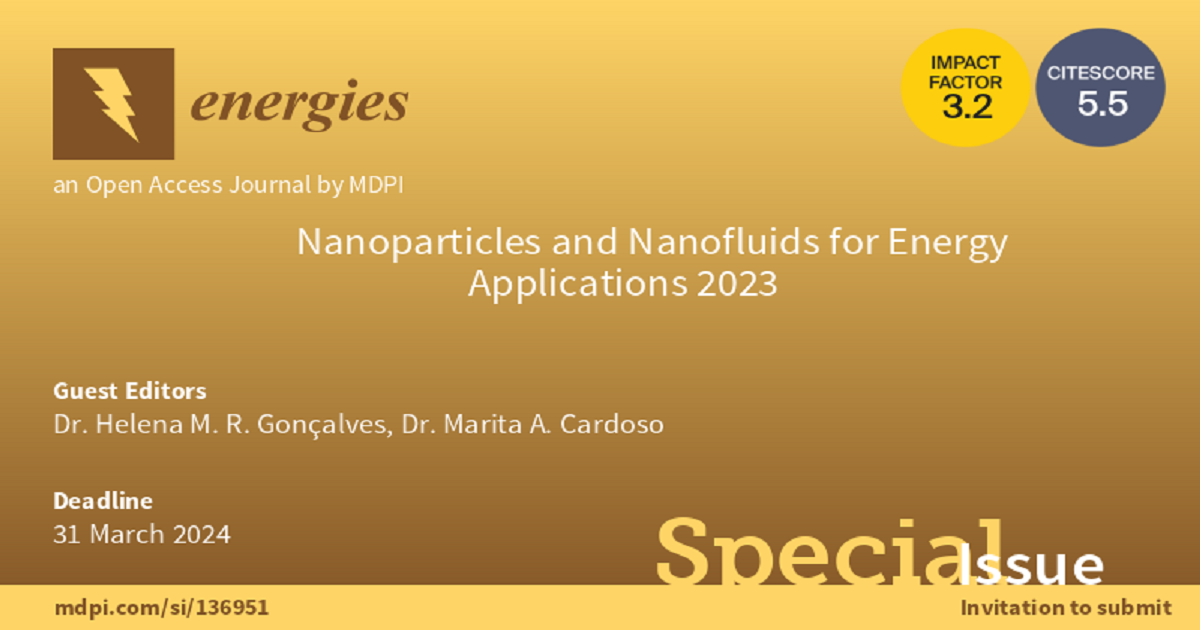Nanoparticles and Nanofluids for Energy Applications 2023
A special issue of Energies (ISSN 1996-1073). This special issue belongs to the section "D1: Advanced Energy Materials".
Deadline for manuscript submissions: closed (31 March 2024) | Viewed by 1280

Special Issue Editors
Interests: nanotechnology; sensors for biomedical and environmental applications; smart nanomaterials for energetic applications
Special Issues, Collections and Topics in MDPI journals
Interests: nanomaterials for nanotechnology; energetic and environmental applications
Special Issues, Collections and Topics in MDPI journals
Special Issue Information
Dear Colleagues,
Energy consumption worldwide is constantly growing, and with it, there is a pressing need to develop new materials that can tackle this demand in a sustainable way. In the building sector, it is of the utmost importance that energy consumption can be counterbalanced with the generation of renewable energy, in situ. We live in a technological world, and in this reality, nanotechnology has a major role. Indeed, the number of nanoparticle/nanodevice applications is ever-growing. The use of nanotechnology in the development of new and alternative methods for pharmaceutical, medicinal, optical engineering, biosensing, and energy applications, among others, has boosted research on new nanoparticles and nanofluids. In the energy area, nanoparticles can be found in, e.g., storage units, luminescent solar concentrators, smart windows, and heat transfer mechanisms. All of these can provide high input in society and in the construction of a sustainable energy future. Nanofluids, for example, have a largely superior performance when compared to the currently employed heat transfer liquids; as such, they are greatly promising for applications in thermal management in sectors ranging from space exploration, automotive industry, and energy storage, to medicine, including cancer therapy. Another interesting application of nanoparticles is in luminescent solar concentrators (LSCs). These devices can potentially transform a building façade into an electricity power generator. As researchers, the possibility of creating a green, sustainable, future for generations to come is in our hands.
Dr. Helena M. R. Gonçalves
Dr. Marita A. Cardoso
Guest Editors
Manuscript Submission Information
Manuscripts should be submitted online at www.mdpi.com by registering and logging in to this website. Once you are registered, click here to go to the submission form. Manuscripts can be submitted until the deadline. All submissions that pass pre-check are peer-reviewed. Accepted papers will be published continuously in the journal (as soon as accepted) and will be listed together on the special issue website. Research articles, review articles as well as short communications are invited. For planned papers, a title and short abstract (about 100 words) can be sent to the Editorial Office for announcement on this website.
Submitted manuscripts should not have been published previously, nor be under consideration for publication elsewhere (except conference proceedings papers). All manuscripts are thoroughly refereed through a single-blind peer-review process. A guide for authors and other relevant information for submission of manuscripts is available on the Instructions for Authors page. Energies is an international peer-reviewed open access semimonthly journal published by MDPI.
Please visit the Instructions for Authors page before submitting a manuscript. The Article Processing Charge (APC) for publication in this open access journal is 2600 CHF (Swiss Francs). Submitted papers should be well formatted and use good English. Authors may use MDPI's English editing service prior to publication or during author revisions.
Keywords
- nanoparticles
- nanofluids
- luminescent solar concentrators
- plasmonics
- smart window devices
- storage energy devices
- heat transfer
- sustainability





